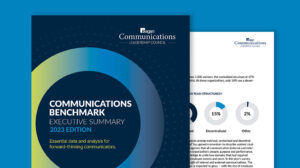9 problems to avoid in hybrid work plans
Give this a careful read to ensure your company is giving workers all they need to thrive amid ongoing uncertainty.

“What causes hybrid workplaces to fail?”
A variety of talent pros weighed in to answer that question. From overwhelming tech-stack options to the formation of competing company cultures, there are numerous ways things can go wrong in a hybrid environment.
Here are nine problems in particular to monitor:
1. “Anything goes” doesn’t actually go.
Hybrid workplaces have the potential to address the needs employees have for flexibility, particularly as safety and well-being are at the forefront of the employee experience. Done right, they can be the perfect balance of inclusiveness, collaboration, flexibility and productivity.
Where hybrid workplaces go wrong is taking an “anything goes” approach. Without a framework for how and when people work and interact, some will be left out of conversations, decisions and opportunities.
Danny Speros, VP of people operations, at Zenefits, shares:
“People Operations can lead their organizations in developing the structure, schedules, communication norms, and feedback loops required to take the best of both in-office and virtual environments. As flexibility increases, being intentional about the work environment is more important than ever, and leaving it to chance risks losing all of the benefits of that flexibility.”
2. Overlooking the importance of mindset.
In the rush to create processes and policies, many leaders are overlooking the importance of mindsets and deeper human needs in relation to hybrid work.
For instance, hybrid work can be seen as an opportunity to optimize high performance while prioritizing the whole person, instead of merely seeing it as the combination of working in the office and at home.
With this mindset, leaders can leverage the best of home and office environments to create new ways of working that boost resilience, performance and culture. For example, leaders can encourage people to digitally disconnect, check in on their employees more, cut meeting time through asynchronous tools, and use office time for deeper strategic sessions.
Marissa Afton, partner & head of global accounts for Potential Project, shares:
“The silver bullet for hybrid work is not found in any particular process but instead in examining how hybrid work is revolutionizing the workplace and how companies can best support the right mindsets to drive this revolution.”
3. Assuming that one size fits all.
One of the biggest mistakes that some employers are making is by continuing to apply “brick and mortar” management practices to a remote or hybrid work environment. In some instances, managers are ill-equipped to oversee a hybrid workforce and fall back to outdated concepts of “if I can’t see you, how do I know you are working?”
Employers must better prepare their managers and employees to be engaged and productive in a hybrid environment. Workplace flexibility with employee schedules, virtual coffee breaks, goal- rather than task-focused performance management, and remote wellness initiatives are just a few ways that many employers can better motivate and engage a hybrid workforce.
Jeffery Palkowski, senior human resources Specialist at The University of Wisconsin-Madison, suggests:
“This is a perfect time to retool past practices and grasp innovative approaches to work in the hybrid world.”
4. Failing to account for workers’ newfound leverage.
We are seeing a huge shift in the bargaining power of labor that we haven’t seen over the past three decades. Not only are companies increasing their wages for lower-income earners, but many corporations are also beginning to offer better benefits to be able to retain their talent from the companies poaching from the coasts.
Ryan Nouis, CEO of TruPath, advises:
“There are a record number of people quitting their jobs. Workers simply have more options to earn better money elsewhere as hybrid workplaces become a common option.”
5. Failing to effectively manage employee performance (and expectations).
Hybrid workplaces are facing struggles managing employees’ performance. In transitioning to remote or hybrid work, many companies skipped crucial steps, such as outlining clear expectations for employees working remotely and setting performance metrics for their remote employees that would encourage success.
In hybrid and remote roles, clear job descriptions are even more essential because expectations need to be set about the essential functions of the job and about how success will be measured.
Heather Whitney, an HR Coach with Paychex, says:
“Performance management in hybrid roles can be especially challenging as managers and employees may not overlap days onsite and thus may be missing key opportunities for connection, whether virtually or in-person. Managers should work with their team to set clear expectations while working on-site or remotely and provide regular feedback about how they are performing against their goals.”
6. Assuming that virtual interactions are enough.
Virtual interaction is not the same as in-person interaction. You lose out on the benefits of a diverse workplace if you’re not actually connecting with your full workplace. Virtual connection has a bias toward connecting us with people who are most like we are. In a hybrid work setting, in-office work days tend to be hyper-focused on catching up with your primary stakeholders.
Brian O’Connor, talent acquisition recruiting manager for DailyPay, offers a reminder:
It will take a greater level of intentionality from team leaders to create space outside of the echo chamber than remote interactions tend to encourage.
7. Creating two different company cultures.
When done right, a hybrid workforce is a great way to attract more talent, provide flexibility for your employees, and ultimately build a happier and more productive team.
Kristin Tschantz, VP of growth marketing at Hireology, shares:
The problem is when companies fail to provide remote employees with the same onboarding experience they provide onsite employees. Over time, this results in a situation where you create two cultures, rather than one. You have your remote culture and your on-site culture. There’s a divide between these two groups of employees and it hinders your ability to maximize productivity, retain your employees, and remain competitive.
8. Missing micro-interactions.
A lack of deep interpersonal engagement is an issue when most of our interactions are remote. There are a host of non-verbal behavioral cues not at our disposal in video chats that would allow us to read a person better and get a deeper sense of how they are doing. Without those important cues, we need to rely more on dialogue and questioning to determine if someone is struggling.
George Vergolias, Medical Director at R3 Continuum, shares this guidance:
“We also need to increase the number of remote interactions with a person to hopefully deepen the dialogue. Pre-pandemic, there were myriad opportunities to have major and micro-interactions with people to gauge how they were doing. In this new hybrid world, this lack of interpersonal engagement risks a reduction in collaborative energy, innovation, and overall engagement over time. This is a new problem to solve, but one leaders and managers must start focusing on more intently.”
9. Sidelining remote workers.
One of the biggest missteps in hybrid workspaces is employers treating remote teammates more like observers than active participants. For instance, livestreaming parties for virtual attendees to watch instead of planning activities that include onscreen and offscreen guests, or giving updates to in-person teams first and sending recap emails to off-site teammates much later.
Michael Alexis, CEO of TeamBuilding, says:
“Virtual teammates should not be an afterthought. Syncing up onsite and remote team members can be tricky. However I think the longer we practice the hybrid model, the easier it will be to naturally and meaningfully integrate remote teammates into the action in real time, and engage staff on- and off-screen.”
Brett Farmiloe is the founder of Terkel, a knowledge platform that converts expert insights into blogs for brands. Read more of his work on TLNT.






